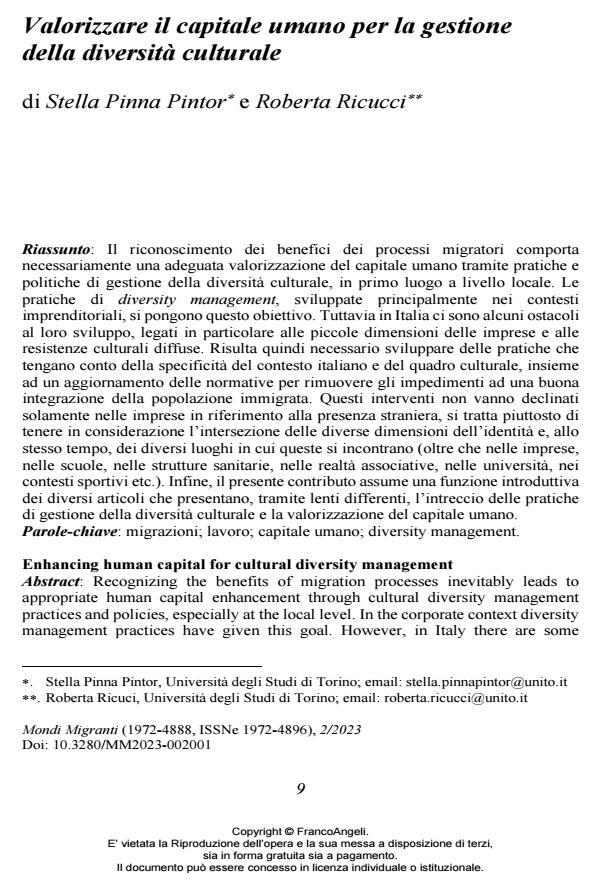Enhancing human capital for cultural diversity management
Journal title MONDI MIGRANTI
Author/s Stella Pinna Pintor, Roberta Ricucci
Publishing Year 2023 Issue 2023/2 Language Italian
Pages 11 P. 9-19 File size 151 KB
DOI 10.3280/MM2023-002001
DOI is like a bar code for intellectual property: to have more infomation
click here
Below, you can see the article first page
If you want to buy this article in PDF format, you can do it, following the instructions to buy download credits

FrancoAngeli is member of Publishers International Linking Association, Inc (PILA), a not-for-profit association which run the CrossRef service enabling links to and from online scholarly content.
Recognizing the benefits of migration processes inevitably leads to appropriate human capital enhancement through cultural diversity management practices and policies, especially at the local level. In the corporate context diversity management practices have given this goal. However, in Italy there are some obstacles to their development, particularly related to the small size of companies and widespread cultural resistance. It is therefore necessary to develop practices that consider the specificities of the Italian context and cultural framework, as well as to update regulations in order to remove obstacles to the successful integration of the immigrant population. These measures should not be rejected only in companies with reference to the foreign presence, but rather it is a matter of taking into account the intersection of the different dimensions of identity and, at the same time, the different places where they meet (in addition to companies, schools, health care facilities, clubs, universities, sports etc.). Finally, this paper serves as an introduction to the various articles that present the intertwining of cultural diversity management practices and human capital improvement from different points of view.
Keywords: migrations; labor; human capital; diversity management.
- Ambrosini M. (2020). L’integrazione degli immigrati: Una mappa concettuale. In: L’integrazione dimenticata: Riflessioni per un modello italiano di convivenza partecipata tra immigrati e autoctoni (pp. 33-40). Roma: Centro studi e ricerche Idos.
- Ambrosini M. (2005). Sociologia delle migrazioni. Bologna: il Mulino.
- Bagaglini M. (2010). Tra integrazione e subalternità: La mobilità lavorativa degli immigrati. Modelli di mobilità occupazionale e carriere lavorative. Milano: Futura.
- Bertossi C. (2011). National models of integration in Europe: A comparative and critical analysis. American Behavioral Scientist, 55, 12: 1561-1580.
- Buemi M., Guazzo G. e Conte M. (2016). Il Diversity Management per una crescita inclusiva: Strategie e strumenti. Milano: FrancoAngeli.
- Campomori F. (2008). Immigrazione e cittadinanza locale: La governance dell’integrazione in Italia (II). Roma: Carocci.
- Campomori F., Baldini M. e Pavolini E. (2021). Il contributo economico dell’immigrazione. In: Dossier Statistico Immigrazione (pp. 317-323). Roma: IDOS.
- Caponio T. (2005). Stranieri in Italia. Migrazioni globali, integrazioni locali. Bologna: il Mulino
- Caponio T. e Pavolini E. (2007). Politiche e pratiche di gestione dei fenomeni migratori. Mondi Migranti, 2007/3: 23-203.
- Chiswick B. and Hatton T.J. (2003). International migration and the integration of labor markets. In: Globalization in historical perspective (pp. 65-120). Chicago: University of Chicago Press;
- Coccia B. (2020). L’integrazione negata. In: L’integrazione dimenticata: Riflessioni per un modello italiano di convivenza partecipata tra immigrati e autoctoni (pp. 33-40). Roma: Centro studi e ricerche Idos.
- De Haas H., Castles S. e Miller M.J. (2020). The Age of Migration: International Population Movements in the Modern World. New York: Guilford Press.
- De Vita L. (2014). Verso l’intersectionality: Un nuovo paradigma per la gestione delle diversità. Verso l’intersectionality: Un Nuovo Paradigma per La Gestione Delle Diversità (pp. 54-67). DOI: 10.3280/SL2014-13400
- Demaio G. (2020). Donne e migrazione: Un protagonismo misconosciuto. In: L’integrazione dimenticata: Riflessioni per un modello italiano di convivenza partecipata tra immigrati e autoctoni (pp. 33-40). Roma: Centro studi e ricerche Idos.
- Esposito T. e Pasca E. (2020). Introduzione. In: L’integrazione dimenticata: Riflessioni per un modello italiano di convivenza partecipata tra immigrati e autoctoni (pp. 33-40). Roma: Centro studi e ricerche Idos.
- Favell A. (2022). The State of Migration Theory: Challenges, Interdisciplinarity, and Critique. In: Migration Theory (4th ed.). London: Routledge.
- Lagomarsino F. e Ravecca A. (2012). Percorsi Interrotti: Le Migrazioni Come Evento Critico Nella Capitalizzazione e Spendibilità Del Capitale Umano (pp. 105-121); DOI: 10.3280/MM2012-002005
- Centro studi e ricerche Idos e Istituto di Studi Politici “S. Pio V.” (2023). Le migrazioni al femminile in Italia. Percorsi di affermazione oltre la vulnerabilità. Roma: Idos.
- Mauri L. e Visconti L. (2004). Diversity management e società multiculturale: Teorie e prassi.
- Ministero dell’Istruzione e del Merito, Direzione generale per i sistemi informativi e la statistica Ufficio di statistica, 2022.
- Monaci M. e Zanfrini L. (2014). Creare valore con la diversità. Sociologia Del Lavoro, 134, 2.
- Thomas Jr R.R. (1990). From affirmative action to affirming diversity. Harvard Business Review, 68, 2: 107-117.
- Tuccio M. (2019). Measuring and assessing talent attractiveness in OECD countries. Brussel: OECD.
Stella Pinna Pintor, Roberta Ricucci, Valorizzare il capitale umano per la gestione della diversità culturale in "MONDI MIGRANTI" 2/2023, pp 9-19, DOI: 10.3280/MM2023-002001